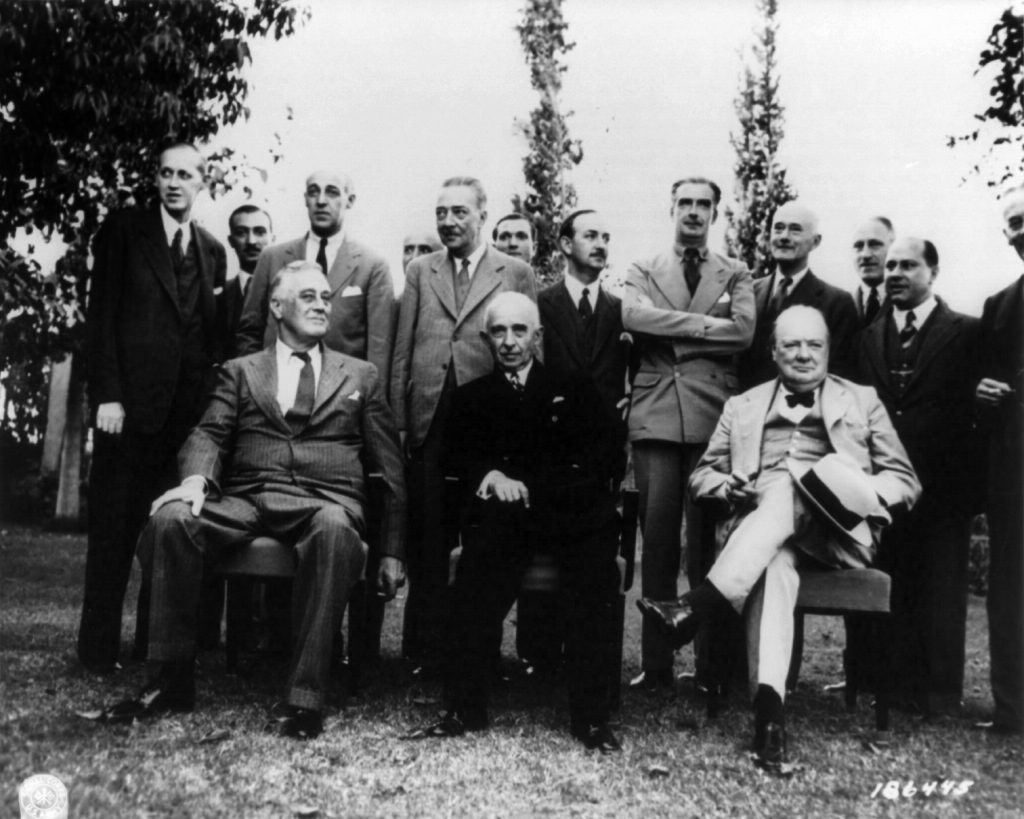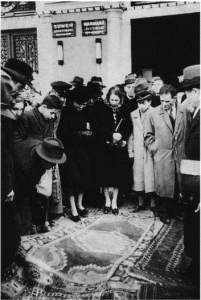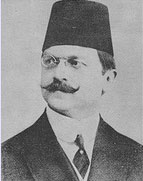Special to the Armenian Weekly

Last month, the Turkish government released a website where Turkish citizens can look up their ancestral roots all the way back until the mid-1850s. There are hundreds of stories in printed and social media, which sent shockwaves in Turkey and beyond, about several Turks who discovered that they had Albanian, Arabic, Pontic Greek, and—worst of all—Armenian roots. There have even been reports that some members of an ultra-nationalistic and racist Turkish party were ostracized and thrown out of their ranks, went into depression, and even committed suicide upon discovering their Armenian family roots.
Whether these stories are true or exaggerated, the subject of one’s roots is critical—and in some cases, deadly— in Turkey. The late Hrant Dink was continuously persecuted, prosecuted for “insulting Turkishness,” and eventually assassinated after revealing that Kemal Ataturk’s adopted daughter and first female military pilot in Turkey, Sabiha Gökçen, was in fact an Armenian girl orphaned during the Armenian Genocide. In another case, a former President of Turkey had sued an opposition Member of Parliament for “accusing and insulting” him by stating that “he came from an Armenian family in Kayseri.”
And yet, in a country where calling someone Armenian is the biggest insult, there are numerous documented and undocumented stories about prominent Turks having Armenian roots, including a past president, another former president’s wife, and several opposition politicians. In one of the documented stories, the family of a past opposition leader—an ultra-nationalistic Turk—was actually converted to Islam from an Armenian family in the Black sea region, whose Armenian descendants now live in Canada.
When this official genealogy website was made public, I immediately wondered how the hidden Armenians’ (Armenians and their descendants, who were forced to convert during the Armenian Genocide) roots were recorded and a quick survey revealed that absolutely none of them were recorded as Armenian. Their family history started only with their adopted Muslim Turkish names. Although there is past evidence that the government kept detailed records of converted Armenians among Turks and Kurds, these records are not made public and are not revealed in this new website. Interestingly, it became evident that many Armenians killed, lost, and deported during the genocide are still marked as being “alive” on the website. Many Armenian families who knew the tragic fate of their grandmothers or grandfathers born all the way back in 1850s, are now finding out that these people are still miraculously alive, according to the doctored records of the website.
I wish here, to relate two interesting—and little known—stories of roots.
A weathly Armenian family lived in a village of Malatya in the 1880s. The region was terrorized and harassed by Kurdish tribesmen, who regularly raided Armenian villages. Eventually, Armenians started organizing defense forces by banding together fedayees (freedom fighters) to protect the Armenian villages. An Armenian fedayee leader once approached the head of this wealthy Armenian family and asked for money to buy weapons and horses. The wealthy Armenian said that he would decide in two days whether to comply with this request or not. After two days, the fedayee returned and the wealthy Armenian refused to give any money. The fedayee promptly shoots the man. The widow of the killed Armenian man fled with her newborn son to Izmir, where she converted to Islam and raised her son with utter hatred toward Armenians. That boy grew up to be Ismet İnönü (1884-1973), the second President of Turkey after Kemal Ataturk—and perhaps one of the worst enemy of the Armenians and other minorities in Turkey, after the Ittihadist (Young Turk) leaders.


İnönü brought forth legislation called the “Wealth Tax” in 1942 (Varlik Vergisi), ostensibly to help Turkey cope with the war economy, but with the intent of ruining the minorities. The taxes were assessed based on ethnic origin—the level of taxation with respect to total capital was 232 percent for the Armenians, 184 percent for the Jews, 159 percent for the Greeks, and only a mere 4.9 percent for the Turks. The payment deadline was 15 days and anyone who could not pay was arrested and sent to the eastern provinces to work as laborers in stone quarries, building roads or tunnels. This was, in effect, a wealth transfer from the minorities to the Turks.
Many Armenians, after selling all their assets at dirt cheap prices, went bankrupt and still could not raise the required amounts and ended up at labor camps and dying there. In 1964, İnönü further oppressed the Greeks, when he deported 45,000 of them who had dual Greek and Turkish citizenship during the Cyprus crisis. They were given ten days to leave behind all their properties, assets, and belongings to leave the country with the allowed $20 and 20 kg (45 lbs) of possessions. The story of Ismet İnönü’s Armenian roots was corroborated by prominent historian Prof. Pars Tuglaci (Parsegh Tuglaciyan) (1933-2016), a family friend of İnönü.
Ali Kemal was a prominent liberal Ottoman journalist and editor of the Ikdam newspaper in the 1910s. He was also a member of the opposition Liberal Union (Itilaf) party and severe critic of the ruling Ittihad Terakki party. He fiercely criticizes the ruling party for entering the war, and for committing “war crimes and massacres” against its own Armenian citizens. His editorials and brilliant political speeches defending the Armenians are so vehement, that the pro-Ittihadist media dubbed him “Artin Kemal” (Artin is an Armenian name, short for Harutiun).

After the war, when Ottoman Turkey was defeated and the Ittihadist leaders fled the country, the Sultan appointed a new government and Kemal briefly became Minister of Interior. Kemal relentlessly demanded prosecution and punishment of the Ittihadist leaders. While he continued his attacks on the Ittihad leaders and defends the Armenians’ rights, he decided to send his British wife and children to England for safety. Unfortunately, the tide turned against Kemal when the resistance started by Kemal Ataturk in Ankara gained power and swept the Sultan and the Istanbul government away. Kemal got caught in the barber shop of Tokatliyan Hotel in Istanbul . While being taken to Ankara for trial, one of Ataturk’s commanders, “Red” Nureddin Pasha (dubbed “Red” for his red beard as well as his bloody cruelty) ordered his soldiers to lynch Kemal who was torn apart limb by limb while still alive.
Kemal’s family settled in Britain and his great grandson eventually became the Mayor of London, and current Foreign Minister of Great Britain, Boris Johnson. As a master diplomat, Johnson continuously tells Turkish President Erdogan that UK will do everything possible to get Turkey into the European Union, but at the same time, advocates Brexit by arguing that if Turkey enters EU, Britain would be flooded by Turkish immigrants.
If it weren’t for stories of tragic roots, politics would be fun.


A fascinating article that demonstrates just how interrelated Turks and Armenians actually are. I’m releasing a new film on the Armenian Genocide this April 2018 that delves further. See https://www.tugg.com/titles/tabu for details.
My mother Siranoosh Gobelian was married abd ge was forced to be in the Turkish Army and one of his buddies returned telling my mother who had an infant son and was told he died because his boots were worn out and his feet got infected and died next to a tree. My mother remarried Nishan Darderian from Sepastia who lost 20 people in his family including the mothers of the children drowning them so they would not see the blood shed and their evil killing methods. I am from their second marriage. My father escaped because of an angel told him in advance there was going to blood shed and he needs o go home and have everyone go to the new country……remember my father was a shepherd a young man. they said you go and come back for us……….which he did and they all perished from the turks
Excellent piece. Thank you.
What is the purpose of the Turkish government making public the info about the roots of its citizens?
Are they planning an ethnic cleansing?
Well done Raffi. History cannot be overturned, it is a fact of life, you cannot change the facts. A very good article – bravo.
Informative profiles of the Monster and the Martyr. The first is Ismet Inonu, who was born Armenian and later became the second President of Turkey. During his reign Inonu heavily taxed Armenians, saying he would “squeeze them like lemons.” The second man is Ali Kemal, who tried to defend Armenian rights and was later torn apart by a Turkish mob who hung a sign on his chest that said, “Artun Kemal,” which was a Turkish insult branding the man an Armenian lover. In recent years in Turkey, Kemal has been considered a Quisling, comparing him to the Nazi-Norwegian leader during World War II. Ironically, Kemal’s great grandson is Boris Johnson, Great Britain’s foreign minister. I don’t think this will help Turkey gain admission into the European Union. A pity — as they say in UK.
Stories such as these send shockwaves through me. Armenians have some of the greatest minds, but at times some of them turn against our cause. Even today, too many examples exist of ignorant hot-heads being placed in sensitive positions, resulting in utter distruction of our comunities…enough said.
Raffi manages to enlighten the present generation with articles about Turkish history that will not be destined to obscurity.
There is evidence that on his deathbed Ismet Inonu coming out of a comma to the astonishment of those keeping vigil around him enquired about the Armenian alphabet. By the time a book on Armenian was fetched from the library Ismet started reciting the Armenian alphabet with his very last breath. Google:- Ismet Inonu Ermenimidir.
What is the address of the new web site. Is it in Turkish
There are several video clips on the internet in Turkish (not websites) from Radyo Saray (a Turkish radio station).
Speaker is Kadir Misiroglu, writer, lawyer, journalist, opponent of Mustafa Kemal Ataturk’s reforms and secularism. Misiroglu’s views are very controversial and disputed indeed.
Be that as it may, one clip is headlined, Ismet Inonu Ermenimidir, is Ismet Inonu Armenian. Another, Ismet Inonu Ermeni alfabesini sayarak oldu, Ismet Inonu died counting the Armenian alphabet.
My father Tateoss Durgerian whom was born in the Village of Sis in 1885, in the Provence of Shabin Karahissar was inducted into the Turkish Military in 1912, whereby the Turks were fighting the Greeks & Bulgarian’s in that Balkan War of 1912-1913. My father did not want to kill Christian Greeks & Bulgarian’s, therefore he fled to the Greek side in 1913, & was later sent to America in 1913 from a relative living in Lowell, Mass. Another brother Levon (khevon) Doorgarian was also inducted in the Turkish Military in 1915 during the 1st World War along with 200,000 other Armenian’s. When they finished their training they were disarmed & put on road building projects & when finished they were taken away in batches of 50 to 100 & forced to build trenches, whereby they were then shot & killed & buried. All 200,000 Armenian’s were massacred, leaving the home front defenseless. My father Tateoss after the War whom was married with 3 children, found out that he lost his wife, father, mother, his 3 children, & many other relatives. Two young brothers & a sister were taken in by Turkish families & Turkified. The two brothers, Krikor & Varteres were circumsized & given Turkish names. After the 1st WW, the Allies went knocking on doors asking if any Armenians wished to come forward & be freed from Turks to come forward, which my fathers 2 brothers & a sister became released from Turks. They were sent to Istanbul and the 2 brothers were unified with my father in the U.S. in Lowell, Mass. & his sister ended up in Cavalla, Greece where she got married to a Safarian & had 3 children. My mother whom was born in the Village of Goteh in the Provence of Erzerum where her whole Village was removed of all Armenian’s & sent on a death march. She, Satenig Vartanian whom was married with 2 children lost her whole family & all her relatives. They bayoneted one of her children & the other starved to death on their death marches. Satenig was the only survivor from her Village of Goteh, now renamed Keutur. She always said, as bad as the Turks were, the Kurds were just as bad in those death marches. She got saved while passing a Catholic or Protestant Missionary Home, whereby they pulled her in and saved her. After the war she also got sent to Istanbul & met my father’s two brothers & she came with them to America in Lowell, Mass. & met my father Tateoss whom they both remarried at the St. Vartanantz Armenian Apostolic Church in Lowell, Mass. in 1920.
Please send us the Armenian Weekly
Very interesting
I couldn’t stay silent on this one. I am referring back to the comment by Arto K. posted on March 21, 2018 about Ismet Inonu and the Armenian Alphabet. Truthfully, Arto I think this was a way for the ultra right in Turkey to disparage the reputation of Inonu for whatever reason by highlighting his Armenians roots. It is true that people in the throes of death revert back to childhood memories and maybe that’s what Inonu did when he was near death. There is no doubt in my mind that the man was an absolute monster and I’ll go one step further and say he was a puppet master too. Ataturk when he ordered the invasion of Dersim was very ill with advanced alcoholism so what better person to encourage him in his sorry quest to destroy the Kurds and hidden Armenians besides Inonu. The painful history of the taxes imposed on Christians is another matter entirely. He did indeed break so many financially and spiritually. So the fact that he remembered the Armenian alphabet on his death bed doesn’t mean “jack shit.” Excuse my expression. I’d like to thank Raffi Bedrosian for a very informative and painful article. KEEP UP THE GOOD WORK!
ELLEN SARKISIAN CHESNUT
My Father’s Mother was a Satenig Vartanian. She migrated to Akron, Ohio with her husband Dono Vartanian. My Father’s Parent died at a young age. I feel so sad after reading this story. How can Ismet Inonu hate and destroy his own People.
I have been deeply involved with Turkish music and culture. I am only now really learning about their historic treatment of Armenians and other minorities. I am dismayed by the continued refusal of the country to take account of its own history. I see it as an enormous chain around the necks of Turks, including those I consider dear friends. I believe it makes them especially vulnerable to the likes of Erdoğan and his ilke. Tanrı onlara yardım etsin (God help them) as the wheels of justice slowly come around.
Hi, I am in my mid sixties and was born in Sepastia. I am an alevi by faith and ethnically Kurdish. However, my maternal grandmother and her a few years older sister were both orphans with no relatives, to my knowledge. They were living in a Kurdish village. Her sister got married in her teens to someone in an Armenian and Kurdish alevi village. My maternal grandfather was from Mileti and he was an orphan as a toddler after the Armenian genocide, and he was brought to Sivas. I remember that my grandparent had an affection for the Armenians at a time many Turks in Sivas or Sepastia hated Armenians. Their best friends were few Armenian families who survived the massacre. After the death of her husband, my grandmother moved to Istanbul. Armenians there used to come and take my grandmother to church whenever there was a wedding or funeral. Before my mother passed away, she said to my brother in Hawaii that her parents were Armenians; and that one of her relatives were denied a high level governmental job, because his family was recorded in archives as Armenian before the genocide. I now understand why my grandfather murmured some words and touched the stone walls of Sumerbank, which was an old Armenian church, whenever when we walked by it. It is all confusing and hard to reconstruct my Armenian ethnicity, but as an American now, I will continue to fight for the rights of both Armenians and Kurds